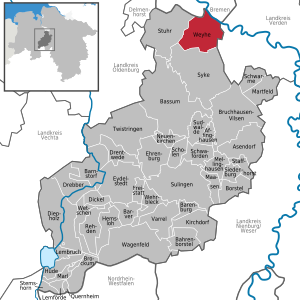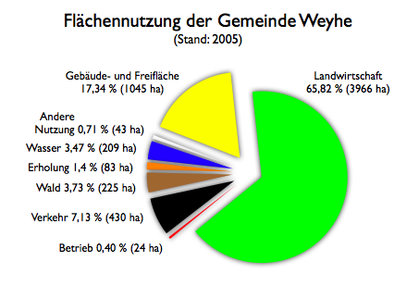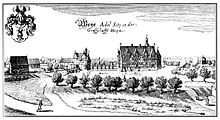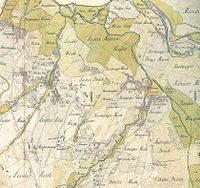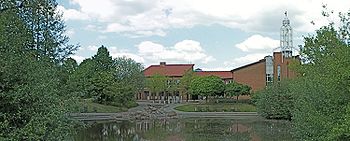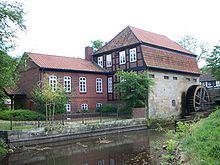Weyhe
| coat of arms | Germany map | |
|---|---|---|
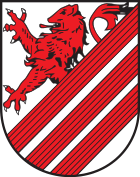
|
Coordinates: 52 ° 59 ′ N , 8 ° 50 ′ E |
|
| Basic data | ||
| State : | Lower Saxony | |
| County : | Diepholz | |
| Height : | 6 m above sea level NHN | |
| Area : | 60.29 km 2 | |
| Residents: | 30,816 (Dec. 31, 2019) | |
| Population density : | 511 inhabitants per km 2 | |
| Postal code : | 28844 | |
| Primaries : | 04203, 0421, 04294 | |
| License plate : | DH, SY | |
| Community key : | 03 2 51 047 | |
| Community structure: | 9 districts | |
| Address of the municipal administration: |
Rathausplatz 1 28844 Weyhe |
|
| Website : | ||
| Mayor : | Frank Seidel ( SPD ) | |
| Location of the community Weyhe in the district of Diepholz | ||
Weyhe is an independent municipality in the north of the Diepholz district in Lower Saxony .
geography
Geographical location
Weyhe connects directly to the southern border of the city of Bremen . In the west, Weyhe borders on the municipality of Stuhr , which is the only one in the Diepholz district to have a larger population than Weyhe. Eastern neighbors are the city of Achim and the joint municipality of Thedinghausen , while Weyhe borders the city of Syke in the south .
Rivers
In the Kirchweyhe district, the Ochtum flows from the Kirchweyher See , which is fed by the Hache and the Süstedter Bach . The Ochtum flows north-west into the state of Bremen and partly forms the border between Lower Saxony and Bremen. Ultimately, the Ochtum flows into the Weser between Lemwerder - Altenesch and Bremen-Seehausen .
The Sudweyher Beeke , which flows into the Süstedter Bach, flows roughly parallel to the Hache through the district of Sudweyhe .
climate
Temperate maritime climate influenced by humid northwest winds from the North Sea . On a long-term average, the air temperature in Weyhe reaches 8.5 - 9.0 ° C and around 700 mm of precipitation falls per year. Between May and August, an average of 20-25 summer days can be expected.
Land use
The land use of the community Weyhe is characterized by agriculture. In 2005, 65.8% of the municipal area was designated as agricultural land. If one looks at the results of the surveys of land use in the period from 1981 to 2005, however, a clear shift in agricultural land in favor of other types of use can be observed. Compared to 1981, the agricultural area was reduced from 4458 ha to 3966 ha, which is a decrease of 11.1%. Land use for buildings and open space increased by 249 ha (+36.4%), the recreational area increased by 49 ha (+144%) and thus more than doubled. The traffic area has increased by 59 ha (+ 16%).
|
||||||||||||||||||||||||||||||||||||||||||||||||||||||||
history
The place name Weyhe appeared around 860. The reason was a report about the miraculous healings at Willehad's grave . The story is about a girl from "ways" (Kirch- or Sudweyhe), who has had no strength in her body for a long time. When she became seriously ill and was taken to the grave of the holy bishop, she regained her strength and health.
About 400 years later, the so-called Weser Bridge List speaks of “two villages”. You can pretty much say that it was Kirchweyhe and Sudweyhe. Kirchweyhe and Sudweyhe are soon to be found in other historical sources as "Kerckwege" (1277) and "Suthweige" (around 1300).
The districts of Angelse, Erichshof, Hagen, Hörden and Melchiorshausen , which belonged to the former municipality of Leeste, stretched in the western half of today's Weyhe municipality. The earliest written references date from around 1185. Among other things, the administrator of the archbishopric Bremen Meierhof in "Leste" (Leeste) is mentioned.
Around 1800 there was a lively exchange of goods between Bremen and Weyhe. Not only agricultural products but also industrial products were in the Weser city traded or offered for sale.
In 1873, the Bremen - Osnabrück railway line opened via Kirchweyhe . As a result, a six kilometer long marshalling yard with few tracks was built in Kirchweyhe, reaching south to the neighboring hamlet of Barrien . Skilled workers moved with their families to Kirchweyhe and ensured a rapid population increase. Around 1925, the railway was still feeding around two thirds of all residents in Kirchweyhe, as well as many families from neighboring communities at the time. The marshalling yard was reduced in size after it was closed in 1968, and the remnants of the northern shed are used by a company.
Timeline
- Around 860: First written mention of Weyhe ("ways") known to this day.
- 1158: Emperor Friedrich I permits the settlement of the hitherto undeveloped breakland in Kirchweyhe and / or Sudweyhe and Dreye .
- 1167: During a nobility revolt against Heinrich the Lion , opponents of the Duke of Guelph conquered the “Castrum Ways” (Weyhe Castle).
- Around 1185: The oldest written reference to the existence of the Leeste district.
- Around 1250: Establishment of the Felicianus Church in the Kirchweyhe district.
- 1582: Kirchweyhe, Sudweyhe and Leeste come under Guelph rule after the Hoya counts die out .
- 1790: The "Kolonie Erichshof" is created on the premises of the Vorwerk Erichshof, which was founded in the 16th century . It is part of the Leeste Lutheran parish .
- 1794: Establishment of the Evangelical Lutheran superintendent, which lasted until 1934.
- 1824: The construction of a " brick kiln " in Sudweyhe is approved. A traditional Weyher branch of industry begins to develop. By 1896, five more businesses were established in the marshes of Ahausen, Leeste, Sudweyhe and Dreye .
- 1826: The Bremen factory owner GF Sengstake founds a soap factory in the Weser village and the customs town of Dreye - a pioneer of industrialization in this part of the town, the largest commercial settlement in Weyhe to this day.
- 1873: Completion of the Bremen – Osnabrück railway line, followed by construction of the marshalling yard.
- 1928: The "Colony Erichshof" is merged with the municipality of Leeste.
- 1945: The final battles around Bremen lead to countless serious destruction in the area of today's Weyhe municipality.
- 1992: Weyhe receives the status of " independent municipality ".
- 2000: The population reaches 30,000.
Church building
On March 1, 1974, the Weyhe community was re-established through the merger of the Kirchweyhe, Leeste and Sudweyhe communities. The total area of the new municipality is 6025 hectares. The districts of Kirchweyhe, Lahausen and Dreye belonged to the municipality of Kirchweyhe, the districts of Sudweyhe, Jeebel and Ahausen belonged to the municipality of Sudweyhe. At the time, the municipality of Leeste with the districts of Leeste, Erichshof, Hörden, Angelse, Hagen and Melchiorshausen was also independent.
*) As of December 31, 2005 |
Population development
The community of Weyhe has seen a sharp increase in population since it was founded in 1974. The population increased between 1974 and 2006 from 21,556 to 30,325 (+ 40%).
politics
Municipal council
The council of the municipality Weyhe consists of 38 women and Council councilors. This is the specified number for a municipality with a population between 30,001 and 40,000 inhabitants. The 38 council members are elected for five years each by local elections. The last municipal council election took place on September 11, 2016. The turnout was 54.6 percent.
The full-time mayor is also entitled to vote in the municipal council.
The last five local elections resulted in the following results:
| year | electoral participation |
CDU | SPD | FDP | Green | The party | The left | ||||||
|---|---|---|---|---|---|---|---|---|---|---|---|---|---|
| % | Seats | % | Seats | % | Seats | % | Seats | % | Seats | % | Seats | ||
| 2016 | 54.6 | 28.3 | 11 | 43.7 | 17th | 10.4 | 4th | 14.7 | 5 | 3.0 | 1 | - | - |
| 2011 | 49.3 | 26.5 | 10 | 45.2 | 17th | 5.4 | 2 | 21.3 | 8th | - | - | 1.6 | 1 |
| 2006 | 46.1 | 27.4 | 10 | 50.3 | 20th | 10.2 | 4th | 12.2 | 4th | - | - | - | - |
| 2001 | 48.3 | 30.6 | 12 | 50.8 | 20th | 7.5 | 2 | 10.9 | 4th | - | - | - | - |
| 1996 | 61.5 | 32.1 | 11 | 48.3 | 18th | 5.4 | 2 | 13.8 | 5 | - | - | - | - |
State elections
| year | electoral participation |
CDU | SPD | FDP | Green | left | NPD | Pirates |
|---|---|---|---|---|---|---|---|---|
| 2013 | 60.1% | 31.9% | 35.8% | 8.2% | 16.4% | 3.2% | 0.8% | 1.9% |
| 2008 | 58.3% | 35.7% | 33.5% | 8.5% | 10.4% | 8.2% | 1.5% | - |
| 2003 | 67.6% | 41.7% | 38.6% | 7.0% | 10.0% | - | - | - |
mayor
The full-time mayor was re-elected on November 10, 2019 after the previous incumbent Andreas Bovenschulte (SPD) was voted out of office at his own request in July 2019 because he switched to Bremen state politics. Frank Seidel (SPD) won the election in the first ballot with 59.8% of the vote.
In the last mayoral election on May 25, 2014, Bovenschulte was elected with 55.6% of the vote. His opponent Nils Krämer received 44.4%. The turnout was 54.3%. Bovenschulte took up his post on November 1, 2014, replacing the previous incumbent Frank Lemmermann (SPD), who was no longer running.
|
Previous incumbents:
Municipal Directors:
|
administration
The municipal administration is mostly housed in the town hall in the Leeste district. Here the citizens will find the building office , the public order office , the residents ' registration office , the registry office and a citizens' office . In addition, the community operates its own construction depot , located on Im Bruch, next to the central sports facility. Its employees take care of the receipt of problematic waste , winter service, street cleaning, the maintenance of sports fields, children's playgrounds and green areas as well as the repair and maintenance of community facilities and buildings. The public order office is responsible for traffic and environmental offenses, and the police station in the Leeste district for all other security issues. The community welfare station is located in the Kirchweyhe district and provides care and care for sick, old and disabled people according to their needs in a familiar, home environment. In 2007 this building was renamed "Martha Schubert House".
coat of arms
The coat of arms of the municipality of Weyhe shows a rising lion over three red diagonal bars. The municipal coat of arms is derived from the coat of arms of the "von Weyhe" family, a dynasty of counts who were probably resident in Weyhe since the 12th century and can also be found elsewhere in northern Germany (including Lüneburg Heath).
Partnerships
- Weyhe has had a partnership with the French Coulaines since 1972 . The IG Weyhe / Coulaines interest group is responsible for the organization and implementation of exchange programs.
- Since 1990, Madona in Latvia has followed as a twin town . The organization and implementation of exchange programs takes place in cooperation with the association for the promotion of the partnership between Weyhe and Madona . In October 2000, for the tenth anniversary of the partnership, the street Madona-Allee in the Kirchweyhe district was inaugurated.
- Weyhe is represented in the Lower Saxony / Bremen municipal association.
Culture and sights
theatre
The privately operated "Weyher Theater", located directly on the market square in Kirchweyhe, is a comedy theater and seats 313 people. Among other things, boulevard pieces, music theater, Low German comedies and Christmas fairy tales are performed. In the 2007/2008 season, over 70,000 spectators attended the theater's 335 performances; thus the Weyher Theater is the most successful comedy theater in northern Germany.
Marketplace
The Kirchweyher Marktplatz is located near the train station and represents today's center of Weyhe. The marketplace is square and relatively large, it has an area of 4225 m², plus parking spaces, surrounding streets and a children's playground. Market day on the market square is on Saturdays from 8 a.m. to 1 p.m. you can get fresh seasonal vegetables and fruits from local suppliers and groceries for your daily needs.
Buildings
Felicianuskirche Kirchweyhe
The Romanesque brick tower of the Kirchweyher ev.-luth. Felicianuskirche dates from around 1250 and is the oldest surviving structure in the community of Weyhe. The originally Romanesque nave had to be closed in 1858 due to dilapidation and was demolished in 1861. In 1863 the new, built in neo-Gothic style, and larger - scale church was consecrated. In 2006 the church got a new Kuhn organ .
Holy Family Kirchweyhe
The Catholic Church Kirchweyhe is on Kirchweyher Hauptstrasse / Drohmweg. There are several services during the week. Diocese is the Diocese of Osnabrück .
Marienkirche Leeste
The Leester ev.-luth. Marienkirche dates from the late 18th century. While the nave, a brick building, was built in 1770, the square west tower was only added 20 years later. The pulpit is from 1770, the gallery from 1852. The large church bell was cast in 1513 and was placed in the west tower in 1770. On the north side of the nave are tombstones from the 17th and 18th centuries.
Railway station and post office in Kirchweyhe
- The building of the Kirchweyher train station was built by the Hamburg-Venloer Eisenbahn and completed in 1873. It is a typical neo-Romanesque brick building with a red-stone-colored architectural style for the time .
- The post office in Bahnhofstrasse was built in 1913 by the innkeeper Johann Koch. It was given up around 2020 by Deutsche Post in favor of a neighboring post office.
Mühlengut Sudweyhe
The Sudweyher watermill and the so-called Sudweyher Gutshof were a common property and an economic unit until 1982. They are located in Sudweyhe on the river Hache . The first documentary mention comes from 1513. The Sudweyher watermill belonged to the farm opposite, a former manor until 1982, and it was bought by the Weyhe community. Next to the Sudweyher watermill is the mill barn, which was probably built in 1807. The community archive is also housed in the building complex of the old watermill with barn, which not only hosts exhibitions of all kinds, but also regular open-air events . The current building of the manor was built around 1819 in place of the dilapidated previous building; the mansion was demolished in 1999.
Lahauser Spieker
The landmark of the Lahausen district, the Lahauser Spieker , was built in 1880 as a half-timbered house. Spieker is the Low German expression for memory . It is located directly on Lahauser Strasse between Lahausen and Jeebel. The building was restored in 1987/89 by all ten local associations in Lahaus. In 1991 the municipality of Weyhe acquired the Spieker. Today the Spieker rehearsal room is the Lahauser stage.
Further buildings are listed in the list of architectural monuments in Weyhe .
Art in public space
Scattered, sometimes somewhat hidden, in the various parts of Weyher, there are some very different sculptures and objects by artists from the region. These art objects are made from a wide variety of materials - bronze , stainless steel , wrought iron, marble , stone and bricks:
- On the grounds of the town hall in Leeste by Thomas Recker, the Against Forgetting (Ziegel, 1993) memorial for all victims of National Socialism ; also the stainless steel sculpture Beeren (1995) by Katharina Franck and the sculpture Figura (wrought iron, 2001) by Elsa Töbelmann and Henning Greve .
- On the market square in Kirchweyhe a mask fountain (1997) made of brick and clay with bronze figures, designed by students from the University of the Arts in Bremen.
- In front of the Sparkasse in Leeste the sculpture group The Five Senses (Stein, 2003) by Norbert Thoss .
- In front of the Sparkasse in Erichshof Die Liegende (marble, 2004) by Amir Amorowitsch.
- A steel sculpture by Herbert Bodzin (1976) near the outdoor pool in Kirchweyhe .
Infrastructure
education
The community of Weyhe has a wide range of educational opportunities; almost all common types of schools are represented. There are six primary schools in the districts of Leeste, Kirchweyhe, Sudweyhe, Erichshof, Lahausen and Melchiorshausen, and two cooperative comprehensive schools in the districts of Kirchweyhe (5th - 10th grade) and Leeste (5th - 12th grade) for around 3,500 pupils. as well as a support center and special school with a focus on learning in the Melchiorshausen district.
The municipality of Weyhe maintains kindergartens in the districts of Leeste, Kirchweyhe, Sudweyhe, Dreye, Erichshof, Lahausen and Melchiorshausen. Nurseries of the municipality are located in the districts Leeste, Kirchweyhe and Lahausen. The independent institutions are located in the districts of Kirchweyhe and Leeste.
There are two public libraries in Weyhe:
- Kirchweyhe Library, Kirchweyhe Cooperative Comprehensive School.
- Leeste Library, Leeste Cooperative Comprehensive School.
Sports facilities
Weyhe has several sports fields. On the one hand, the cooperative comprehensive schools in Kirchweyhe and Leeste are each equipped with multi-purpose halls and sports fields.
The central sports facility (ZSA) of the community is located in the Leeste district, right next to the town hall. There are soccer and tennis courts for the clubs TSV Weyhe-Lahausen and SC Weyhe, a tartan track, a long jump facility, a multi-purpose hall and a restaurant. A second artificial football pitch was completed in October 2011.
In the Melchiorshausen district, on the B6 directly behind the "Village" party room, there is the tennis facility of the pure tennis club TC 71 Weyhe with its own clubhouse.
The Weyher outdoor pool, built in 1974/75, is located in the Kirchweyhe district and has a 50 m pool, a 5 m diving platform, a swimmer's pool, a non-swimmer's pool, as well as a children's pool and a water slide. In a small heated indoor pool there is a teaching pool which is offered to schools in the mornings and all other bathers in the afternoons during the winter season. The outdoor pool is located in the middle of a large outdoor area not far from the Hache and is surrounded by old trees.
societies
There are numerous traditional sports and shooting clubs in the community of Weyhe, including the largest club SC Weyhe , whose American football team played in the 2nd Bundesliga in the 2004 and 2007 seasons. The U-17 (B-Jugend) will play in the Bundesliga-Nord in the 2009/2010 season. Together with the PRO YOUgend e. V. Leisure activities for children and young people. Another traditional sports club is TSV Weyhe-Lahausen e. V. 1949. Football, gymnastics, badminton, netball and hiking are offered.
Churches, religion
Denomination statistics
Currently (as of 2018) of the 30,998 inhabitants of Weyhe, 12,392 (40.0%) are Protestant , 2,181 (7.0%) are Catholic and 16,425 (53.0%) have any other religious affiliation or are non-denominational . In 2015, 14,133 of the population of Weyhe were Protestant, 2,372 Catholic and 660 of other religions. 14,653 people had no religious affiliation in 2015.
Economy and Transport
Established businesses
The Dreye district, with almost 150 businesses, forms the focus of Weyhe's business. Companies such as Aldi- Nord with a regional branch and its own coffee roastery, Vakumix AG, Dachdeckereinkauf Nordwest eG, Hofmeister & Meincke GmbH & Co, Bultmann Produktions- und Vertriebs GmbH and Cadillac Plastic GmbH have settled one kilometer from the federal motorway 1 . In the district of Leeste, the nationally known Fruchtsaftkelterei Hans Döhle GmbH (Goldquell) has had its production site for more than 50 years, but stopped production in 2011.
traffic
- Rail transport
Weyhe is on the heavily frequented Wanne-Eickel – Bremen – Hamburg railway , the traffic axis between the Ruhr area and north-west Germany . Since December 2010 trains of the regional S-Bahn Bremen / Lower Saxony have been operating here . There are plans to extend the tram line 8 of the Bremer Straßenbahn AG beyond Huchting on the tracks of the Bremen-Thedinghauser Eisenbahn via Stuhr and Brinkum to Weyhe-Leeste.
- The district of Kirchweyhe has a train station where regional express trains of Deutsche Bahn stop on the Bremen or Bremerhaven-Lehe – Osnabrück (RE 9) line and the RS 2 line of the NordWestBahn .
- The Dreye district also has a stop on the Bremen – Osnabrück railway line. Only trains on line RS 2 of the NordWestBahn stop here.
- The Melchiorshausen district can also be reached via the Barrien stop in the neighboring municipality of Syke . Here, too, only trains on the RS 2 line of the NordWestBahn stop.
- Road traffic
Weyhe can be reached via two exits from Federal Motorway 1 :
- The districts of Leeste, Erichshof, Hörden and Melchiorshausen via the Bremen / Brinkum exit.
- The districts of Dreye, Kirchweyhe, Lahausen, Sudweyhe and Jeebel via the Bremen-Arsten exit.
Weyhe is part of the Bremen / Lower Saxony transport association. The following bus lines serve Weyher districts:
- Line 102: Bremen Hbf - Bremen-Neustadt - Brinkum - Melchiorshausen - Syke.
- Line 120: Bremen Hbf - Bremen-Neustadt - Brinkum - Leeste - Kirchweyhe.
- Line 121: Bremen Hbf - Bremen-Neustadt - Dreye - Kirchweyhe.
- Air traffic
- The Bremen airport is about 15 km away and is on the national highway 6 to achieve.
- Shipping
- The Dreye district is located directly on the Weser and has a marina in the Wieltsee , which was created through gravel mining .
Personalities
Sons and daughters of the church
- Charlotte von Eine (1756–1833), muse of the Göttingen Hainbund
- Johann Heinrich Rumsfeld, ancestor of the former US defense minister Donald Rumsfeld , came from Sudweyhe and emigrated to the United States of America in 1876.
- Louise Ebert (1873–1955), wife of Friedrich Ebert , the first German Reich President
- Heinz Warneke (1895–1983), German-American sculptor
- Heino Wiese (* 1952), politician (SPD)
- Katja Riemann (* 1963 in Kirchweyhe), actress
- Luca Zander (* 1995), soccer player
- Michael Rosemann (* 1967), German university professor and honorary consul in Brisbane, Australia
Personalities who work or have worked on site
In alphabetical order
- Dirk Busch (* 1951 in Brunsbüttelkoog ), singer, composer, lyricist, producer and arranger
- Hermann Greve (* 1957 in Weyhe-Sudweyhe), author
- Dennis-Kenji Kipker (* 1987 in Ibbenbüren ), information lawyer at the University of Bremen
- Felix Kracht (1912–2002), engineer and pilot, one of the fathers of Airbus Industries (first production director)
- Ursel Meyer-Wolf (1944–2020), Low German author
- Rolf Stünkel (* 1954 in Hildesheim ), writer, photographer, fighter and traffic pilot
- Gabriele Ullrich (* 1960 in Syke -Okel), author
- Falko Weerts (* 1942 in Emden ), Low German author and moderator
- Arnd Zeigler (* 1965 in Bremen), moderator, journalist, author and singer
literature
- Wilfried Meyer: Weyhe - dates, events, pictures of a community . WM-Verlag-Weyhe, 1999, ISBN 3-9807444-0-X .
- Wilfried Meyer: Weyhe im Wandel der Zeit, Volume 1. 1981, 2nd revised edition 1986, 3rd revised edition 2006, WM-Verlag, Weyhe, ISBN 3-9807444-6-9 .
- Wilfried Meyer: Weyhe im Wandel der Zeit, Volume 2. WM-Verlag, Weyhe 2005, ISBN 3-9807444-4-2 .
- Wilfried Meyer: Weyhe in the course of time, Volume 3. WM-Verlag, Weyhe 2011, ISBN 978-3-9812556-5-2 .
Web links
- Official website of the Weyhe community
- Photos from around the Sudweyher Gutshof, from the watermill and from the Hache
- ( Page no longer available , search in web archives: The geological structure of the Kirchweyher soil )
- Our Weyhe - Weyher Citizen Portal
Footnotes
- ↑ State Office for Statistics Lower Saxony, LSN-Online regional database, Table 12411: Update of the population, as of December 31, 2019 ( help ).
- ^ Lower Saxony State Office for Statistics, Hanover. Cadastral area in Lower Saxony
- ↑ Wilfried Meyer: Weyhe in the course of time . 3rd revised edition, WM-Verlag-Weyhe, 2006, ISBN 3-9807444-6-9 .
- ↑ Wilfried Meyer: Weyhe in the course of time. Volume 2 . WM Verlag-Weyhe, 2005, ISBN 3-9807444-4-2 .
- ^ E. Preuss: single sheet about the letter Kirchweyhe. From: The large archive of German train stations. 63 supplementary delivery, 2006.
- ^ Federal Statistical Office (ed.): Historical municipality directory for the Federal Republic of Germany. Name, border and key number changes in municipalities, counties and administrative districts from May 27, 1970 to December 31, 1982 . W. Kohlhammer, Stuttgart / Mainz 1983, ISBN 3-17-003263-1 , p. 190 .
- ^ Lower Saxony State Office for Statistics, Hanover. Area, population and population movement in Lower Saxony
- ^ Lower Saxony Municipal Constitutional Law (NKomVG) in the version of December 17, 2010; Section 46 - Number of MPs , accessed on November 10, 2014.
- ↑ Mayor Weyhe: Seidel succeeds Bovenschulte (NDR) , accessed on November 11, 2019.
- ↑ Individual results of the direct elections on May 25, 2014 in Lower Saxony , accessed on November 10, 2014.
- ^ Felicianus Church in Kirchweyhe. ( Memento from February 12, 2013 in the web archive archive.today ) weyhe.de
- ↑ weyhe.de
- ↑ Weyhe community population statistics, page 46, accessed on November 22, 2019
- ↑ weyhe.de

